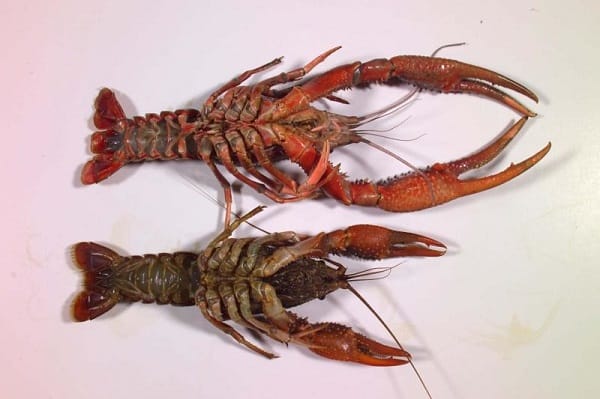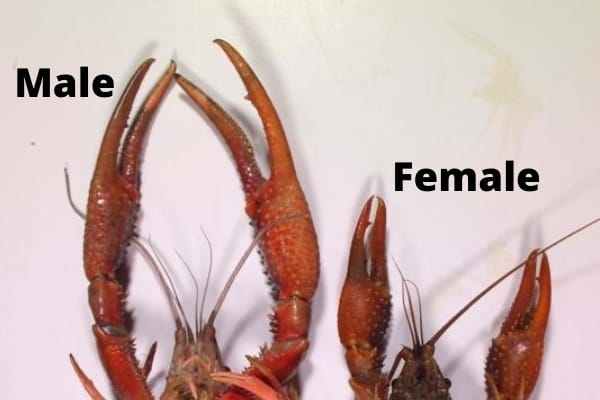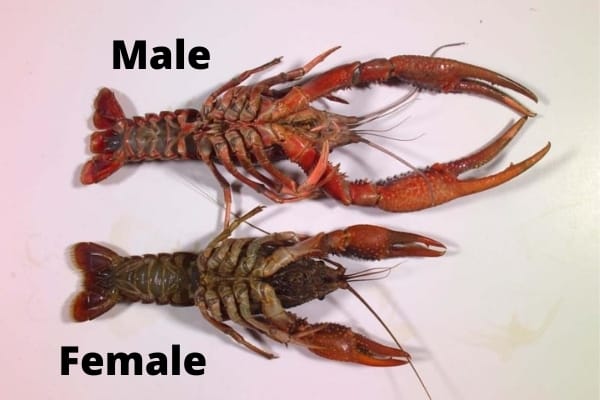This post was created with help from AI tools and carefully reviewed by a human (Muntaseer Rahman) . For more on how we use AI on this site, check out our Editorial Policy.
Check Out These FREE Tools We Made JUST For You!
Male vs Female Crayfish: How to Tell the Difference

You ever just stare at your crayfish and think, “Are you a dude or a lady?”
Yeah, me too.
Turns out it’s not that obvious when you’re looking at what basically amounts to a tiny freshwater lobster chilling in your tank.
But knowing whether you’ve got boys or girls matters way more than you’d think—especially if you don’t want to wake up to 100-150 baby crayfish one morning because your “two males” turned out to be a couple.
So let’s figure this out together.
Why You Actually Need to Know This
Before we get into the anatomy lesson, here’s why this isn’t just nerdy curiosity.
If you’re keeping multiple crayfish, you should stick to one male with multiple females—males fight like they’re in some underwater UFC tournament.
Plus, knowing the sex helps you understand their behavior better.
Your seemingly chill crayfish might just be getting ready to flip another male onto his back and start some drama.

Quick Reference Table
| Feature | Males | Females |
|---|---|---|
| Gonopods | Large, rigid, visible | Barely visible or absent |
| Swimmerets | 3 pairs (2 became gonopods) | 5 pairs |
| Size | Usually larger | Usually smaller |
| Claws | Bigger, thicker | Smaller (usually) |
| Tail | Narrow, tapered | Wide, rounded |
| Hooks | Present on 2nd walking legs (F1 form) | Absent |
| Gonopores | At base of 5th legs | At base of 3rd legs |
| Aggression | More aggressive | Slightly less aggressive |

The Most Reliable Way: Check the Gonopods
Alright, this is the gold standard method, but it requires you to actually pick up your crayfish and look at its belly.
I know, I know—those claws look scary.
But trust me, it’s worth it.

What Are Gonopods?
Males have gonopods, which are small legs adapted for depositing sperm.
They’re basically modified swimmerets (those little leg-like things on the tail).
In males, the gonopod is very developed and large, while in females you’ll barely be able to see it.
Think of it like this: males have these two white, rigid structures tucked between their walking legs that look like mini legs pointing forward.
Females? They’ve got nothing that obvious—just regular swimmerets all the way down.
How to Actually Check This
Put your crayfish in a clear container and look from underneath.
Or be brave and carefully pick them up (they won’t stay out of water for 60 seconds, don’t worry).
Males in the Astacoidae family have only three pairs of swimmerets under the abdomen, while females have five.
So if you can count, you can sex your crayfish.
Males literally have fewer because two pairs got turned into those gonopods.
The Size Game: Bigger Usually Means Male
Males are larger, with narrower tails and bigger claws.
But here’s the catch—this only works well with adults.
Baby crayfish? Good luck.
Some species like dwarf crayfish grow to only 2 inches, making size differences nearly impossible to spot.
Plus, a young female might be smaller than an older male even if they’re different ages.
So yeah, size helps, but don’t bet your entire setup on it.

Claws: The Flex Factor
Males tend to have bigger, beefier claws.
Makes sense, right? They use their claws to fight off other males and to attract, secure, and position females during mating.
It’s like the crayfish version of showing off at the gym.
Males often have one claw significantly larger than the other—the “crusher claw”—used for defense and mating.
But before you make your final call based on claws alone, remember this: females can have larger claws than males if the males have been regenerating claws from fights.
Your big-clawed crayfish might just be a girl who kept her claws while the boys kept losing theirs in brawls.

The Tail Tells a Story
Males have narrower, more tapered abdomens, while females have broader, more rounded tails.
Why? Because mama crayfish needs room for all those eggs.
Females can lay up to 800 eggs depending on species, though most won’t survive.
When they’re “berried” (carrying eggs), females look like they’re hauling around a bunch of tiny grapes under their tail.
Females have larger, stronger swimmerets to help create a safe environment for young crayfish.
It’s basically built-in baby-carrying infrastructure.
Special Features: Hooks and Holes
Here’s where it gets weirdly specific.
In breeding form (F1), males develop spiny hooks on their second pair of walking legs for clasping onto females during mating.
Yes, you read that right—they literally grow hooks seasonally.
Males molt twice per year and cycle between breeding (F1) and non-breeding (F2) forms.
So your male might look slightly different depending on when you check.
Meanwhile, females have paired sexual openings called gonopores at the base of the third pair of legs.
In North and Central American crayfish, females also have a small depression called the annulus ventralis between the fourth and fifth walking legs where they store sperm until fertilization.
Nature is wild, y’all.
What About Behavior?
Males are often more aggressive than females, chasing away intruders and engaging in fights with other males.
But don’t assume females are peaceful little angels.
They’ll definitely throw down if they need to—they’re just slightly less likely to start the fight.
During mating, males turn females onto their backs and release sperm packets.
If you see this happening, congrats—you’ve identified both sexes at once.
The “Just Look at Cherax” Cheat Code
If you’ve got a Red Claw crayfish (Cherax quadricarinatus), you hit the jackpot.
Males have a red-colored patch on the outer margin of their claw—hence the name “Red Claw.”
Boom. Done. No belly-checking required.
But for most species? You’re gonna have to work for it.
The Bottom Line
You shouldn’t rely on abdomen shape, size, or coloration alone—these should be used in combination.
The only 100% reliable method is checking for gonopods or counting swimmerets.
Everything else is just supporting evidence.
And look, if you’re still not sure after all this? Take a clear photo of your crayfish’s underside and post it to a crayfish forum.
Those folks live for this stuff.
Why This Actually Matters
Beyond avoiding surprise babies, knowing your crayfish’s sex helps you provide better care.
You’ll understand why your male is constantly picking fights.
You’ll know why your female is hiding more when she’s berried.
You’ll be able to set up your tank properly—one male, multiple females, plenty of hiding spots.
And honestly? It’s just cool to know your pets that well.
These little crustaceans are way more complex than most people give them credit for, and taking the time to understand them makes keeping them infinitely more rewarding.
Now get out there and check some crayfish bellies.
Just watch those claws.
About Author
Hello, I’m Muntaseer Rahman, the owner of AcuarioPets.com. I’m passionate about aquarium pets like shrimps, snails, crabs, and crayfish. I’ve created this website to share my expertise and help you provide better care for these amazing pets.
Disclaimer
This site is owned and operated by Muntaseer Rahman. AcuarioPets.com is a participant in the Amazon Services LLC Associates Program, an affiliate advertising program designed to provide a means for sites to earn advertising fees by advertising and linking to Amazon.com. This site also participates in other affiliate programs and is compensated for referring traffic and business to these companies.

